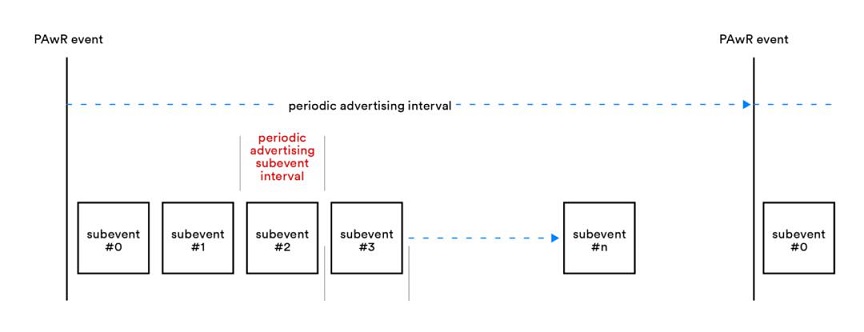The Bluetooth SIG recently announced a new feature specifically conceived for the Electronic Shelf Label (ESL). The feature so called Periodic Advertising with Responses (PAwR) which is encapsuled in Bluetooth 5.4 standard introduces a new transmission logic that enables a single access point to conduct two-way communication with thousands of terminal nodes without established links. It aims to to bring more space for innovation to the ESL industry, not only enabling bidirectional communication between ESLs and Bluetooth hubs, but also significantly reducing their power consumption.

What is An Electronic Shelf Label
When shopping in stores or supermarkets, it is easy to find that traditional paper price tags are being replaced by electronic shelf labels. Retail giants in China and abroad such as Freshippo, Yonghui Superstores, Sam Club, and Metro have massively adopted electronic shelf labels as standard accessories. In addition, applications similar to ESLs getting adoption in other business scenarios i.e. table cards in exhibitions, venue access cards, patient cards in hospitals and BOM cards in factories, etc.

An ESL is an electronic ink display device with an embedded communication module enabling data reception. It displays basic product information, prices, barcodes or QR codes, and even other basic images. What's more, its most significant and mandatory feature is "low power consumption and long autonomy", which typically achieve a battery life of several months or even years.
ABI Research predicts that by 2027, 2.4 billion ESL devices are supposed to be installed in various retail stores. Communication protocols commonly used by ESLs are the 2.4G proprietary protocols, ZigBee, and BLE. Each protocol has its own pros and cons. Thanks to its versatility and rich ecosystem, BLE has become more popular and is being adopted by more and more manufacturers and retail stores. Research data shows that the penetration rate of ESL in China is still below 10%. And its adoption mainly concentrates in large supermarkets. It make sense to believe that there is still huge market potential to tap in China, since middle and lower tier markets there has yet been addressed.
What is PAwR
PAwR is a communication method similar to periodic broadcast (PADVB). It allows application data to be transmitted from a broadcasting device (broadcaster) to one or more receiving devices (observers), following a one-to-many communication topology. Both PAwR and PADVB use a connectionless communication method, in which the transmission of broadcast packets is periodic, at regular intervals, without random scheduling. The difference in between: PAwR supports bidirectional communication between the broadcaster and observers; whereas, PADVB does not support observers to send response packets to the broadcaster.
Advantages of PAwR
PAwR Events and Subevents
The periodic part of the PAwR refers to the periodic broadcasting of packets by a central device like an access point, which occurs at precise and regular intervals. Communication occurs in bursts of activity during periods of time called events. An event can be divided into multiple subevents.

Subevents are further divided into time slots which are used for the transmission of one packet by the central Broadcaster device, by several time slots during which to receive responses from Observer devices.

PAwR defines procedures by which Observer devices can acquire the event and subevent schedule of the Broadcaster. Other procedures define how the Observer is allocated a specific subevent during which to listen and a response slot within that subevent to use for replies. Assigning devices to specific subevents only means that they switch into receive mode infrequently, substantially increasing battery life.
PAwR is designed to accommodate data that changes at every transmission and is delivered to individuals or groups of devices. Application logic ensures that data transmitted in each subevent is relevant to the devices listening at that time, so there is little wasted energy.
PAwR is essentially stateless, and this makes it very scalable. Bi-directional, one-to-many communication involving thousands of devices like ESLs is achievable using PAwR.
Novas perspectivas para PAwR e ESL
A alteração automatizada de preços no sistema ESL melhorou a eficiência operacional da loja e melhorou significativamente a satisfação do cliente. Ao mesmo tempo, os novos recursos da tecnologia Bluetooth desenvolvidos em conjunto pelos líderes da indústria da ESL e o Bluetooth SIG indicam que um novo padrão da indústria para o mercado de etiquetas eletrônicas está chegando. Para expandir o mercado endereçável, o próximo passo é fazer com que os provedores de soluções ESL migrem seus sistemas para tecnologia sem fio baseada em padrão. Apresentando o padrão sem fio para o mercado ESL, a tecnologia Bluetooth ajudará o setor de varejo a entrar no próximo estágio da transformação digital, proporcionando melhores resultados para lojas e compradores.
Sobre a tecnologia RF-star
A RF-star é uma empresa de alta tecnologia com foco em dispositivos de radiofrequência e foi certificada pela Texas Instruments como uma IDH terceirizada de produtos de RF de baixa potência por mais de uma década. A RF-star fornecemódulos sem fio IoTe um conjunto completo de soluções,incluindoBLE,Wi-Fi, Matter, Wi-SUN,Sub-1G,ZigBee, Thread, etc.Para mais informações, visite o site da empresahttps:// www.rfstariot.com/ou contate-nos eminfo@szrfstar.com.